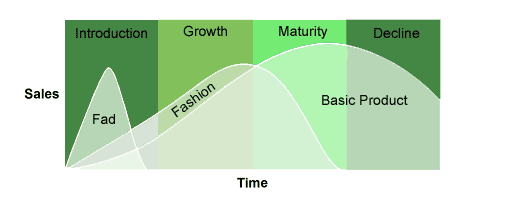

|
Product Items, Lines, and Brands |
Copyright 2006
Cornell
University.
All rights reserved.
| Basic, Fashion, and Fad Products
Apparel and other consumer products can be classified by the length of their life cycles. Basic products such as T-shirts and blue jeans are sold for years with few style changes. Businesses selling basic products can count on a long product life cycle with the same customers buying multiple units of the same product at once or over time. The life cycle curves of basic, fashion, and fad products are pictured below.
Life Cycle for Basic and Fashion Products Fashion product life cycles last a shorter time than basic product life cycles. By definition, fashion is a style of the time. A large number of people adopt a style at a particular time. When it is no longer adopted by many, a fashion product life cycle ends. Fashion products have a steep decline once they reach their highest sales. The fad has the shortest life cycle. It is typically a style that is adopted by a particular sub-culture or younger demographic group for a short period of time. The overall sales of basic products are the highest of the three types of products, and their life cycles are generally the longest. Apparel products often have a fashion dimension, even if it is just color. As fashion features increase in a product, the life cycle will decrease. Therefore, if you are designing a fashion product, you will want to have multiple products in line for introduction as each fashion product's cycle runs its course. Some firms build their lines to include basic, fashion, and fad products in order to maximize sales. For example, with a sweater line, a business may have four styles that have classic styling and colors and are always in the line. Four additional styles may be modified every two years to include silhouette, length, and collar changes based on the current fashion. One or two short-cycle fashion or fad styles based on breaking trends may be introduced once or twice a year. Styles that a popular celebrity or sports hero is wearing are examples of fashion and fad styles. We can also look at the number of fashion product adopters against time.
Fashion Adoption Consumer Types Different marketing strategies should be used to reach each of these consumer types.
|


